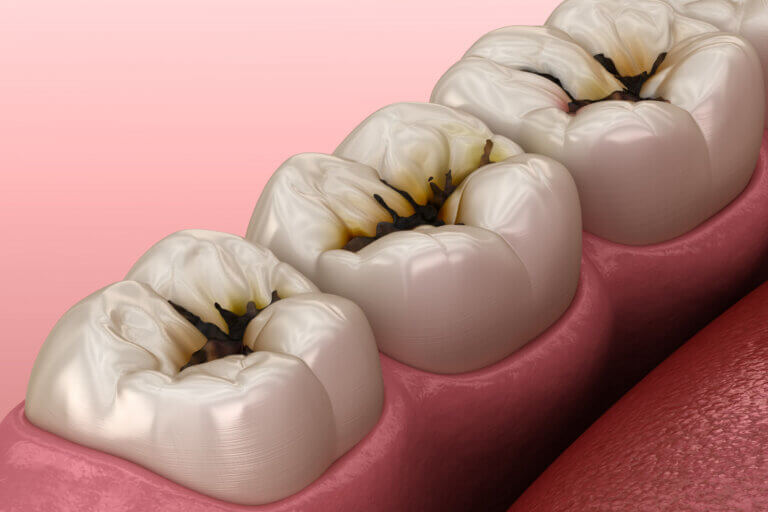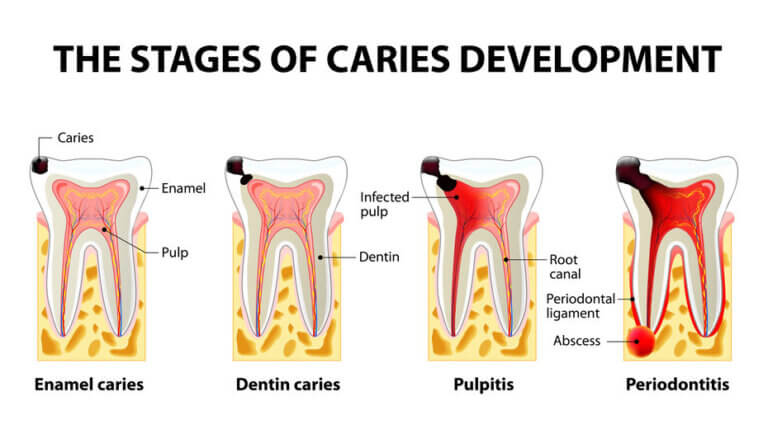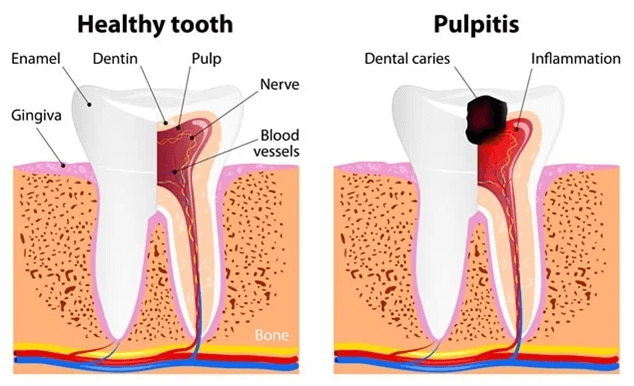Reversible Pulpitis

What Is Reversible Pulpitis?
Reversible pulpitis is a mild inflammation of the tooth pulp, the inner tissue of your tooth that contains nerves and blood vessels. This condition is often triggered by irritants such as cavities, minor trauma, or extreme temperatures.
Unlike its more severe counterpart, irreversible pulpitis, the inflammation in reversible pulpitis is temporary, and the pulp can heal with proper treatment. However, if left untreated, the condition may progress to irreversible pulpitis, requiring more invasive procedures like a root canal treatment or even tooth extraction.
Before you contact a Toronto dentist to examine Reversible Pulpitis, there are some things you should know as a patient:
- Why Do I Have Reversible Pulpitis?
- Signs And Symptoms Of Reversible Pulpitis
- Treatment Options For Reversible Pulpitis
- Managing Reversible Pulpitis Until You Can See The Dentist
- Frequently Asked Questions About Reversible Pulpitis
If you have questions about Reversible Pulpitis or other dental problems, please contact us for more information.
Why Do I Have Reversible Pulpitis?
Several factors can lead to reversible pulpitis:
- Cavities: Untreated cavities can expose the pulp of your tooth to harmful bacteria. These bacteria can cause irritation and inflammation, leading to pulpitis.
- Dental Trauma: Accidents or injuries that damage the tooth, like cracks or fractures, can expose the pulp, making it vulnerable to infection and inflammation.
- Tooth Grinding: If you grind your teeth, you can wear down the enamel, exposing the pulp. This friction and pressure can result in inflammation of the pulp.
- Dental Procedures: Treatments like deep fillings or crown placements may temporarily irritate the pulp.
Understanding the underlying causes of Reversible Pulpitis is the first step in preventing or addressing this condition effectively. For more information about Reversible Pulpitis, please contact us.

Signs And Symptoms Of Reversible Pulpitis
Reversible pulpitis can often be identified by the following symptoms:
- Sensitivity to Temperature: Sharp pain when consuming hot, cold, or sugary foods and beverages.
- Localized Pain: Discomfort typically centered around a specific tooth.
- Intermittent Pain: Pain comes and goes, often subsiding after the stimulus is removed.
- No Swelling or Abscess: Unlike irreversible pulpitis, there’s no visible swelling or abscess formation.
- Pain on Biting: Mild discomfort when chewing or applying pressure to the affected tooth.
If you notice these symptoms, it’s essential to consult your dentist promptly to prevent further complications. For more information about Reversible Pulpitis, please contact us.
Treatment Options For Reversible Pulpitis
Reversible pulpitis can often be managed with straightforward treatments. Here are the most common options:
- Dental Filling: If cavities are the cause, your dentist will remove the decay and restore the tooth with a filling.
- Desensitizing Toothpaste: Specialized toothpaste like Sensodyne can help alleviate tooth sensitivity.
- Fluoride Treatments: Fluoride strengthens enamel, reducing sensitivity and protecting against future cavities.
- Pulp Capping: If the pulp is exposed but minimally affected, your dentist may seal it with a protective layer to encourage healing.
- Night Guards: If bruxism is a contributing factor, wearing a night guard can prevent further enamel damage.
The best treatment depends on the underlying cause, so a professional evaluation is crucial. For more information about Reversible Pulpitis, please contact us.

Managing Reversible Pulpitis Until You Can See The Dentist
While waiting for your dental appointment, you can take these steps to manage the discomfort:
- Over-the-Counter Pain Relief: Medications like ibuprofen or acetaminophen can help reduce pain and inflammation.
- Cold Compress: Apply a cold pack to the cheek near the affected area to numb pain and reduce swelling.
- Avoid Trigger Foods: Steer clear of hot, cold, or acidic foods and beverages.
- Saltwater Rinse: Rinse with warm saltwater to reduce bacteria and soothe inflammation.
- Use Desensitizing Toothpaste: Apply it directly to the affected tooth for temporary relief.
These are temporary measures; visiting your dentist for a definitive solution is essential. For more information about Reversible Pulpitis, please contact us.
Frequently Asked Questions About Reversible Pulpitis
- How is reversible pulpitis different from irreversible pulpitis?
Reversible pulpitis causes temporary inflammation that can heal with treatment, whereas irreversible pulpitis involves permanent damage to the pulp and typically requires a root canal or extraction.
- Can reversible pulpitis go away on its own?
In some cases, mild irritation may subside, but it’s best to consult a dentist to address the underlying cause and prevent progression to irreversible pulpitis.
- Is reversible pulpitis painful?
Yes, it can cause sharp, fleeting pain, especially in response to hot, cold, or sweet stimuli. However, the pain typically subsides when the irritant is removed.
- Can I prevent reversible pulpitis?
Yes, maintaining good oral hygiene, using fluoride toothpaste, and visiting your dentist regularly for check-ups can help prevent reversible pulpitis.
If you suspect you have reversible pulpitis or have questions about your dental health, don’t wait. Contact us at Atlas Dental today to schedule an appointment. Our experienced team is here to help you achieve a pain-free, healthy smile!

